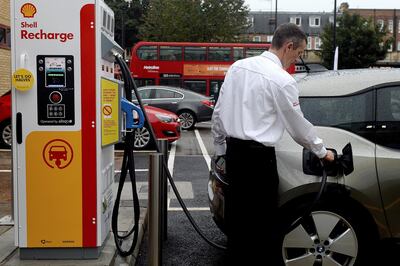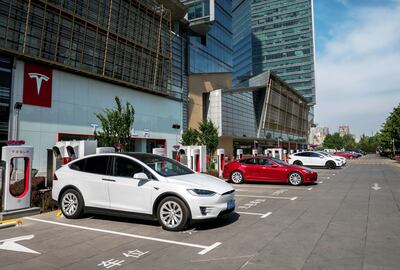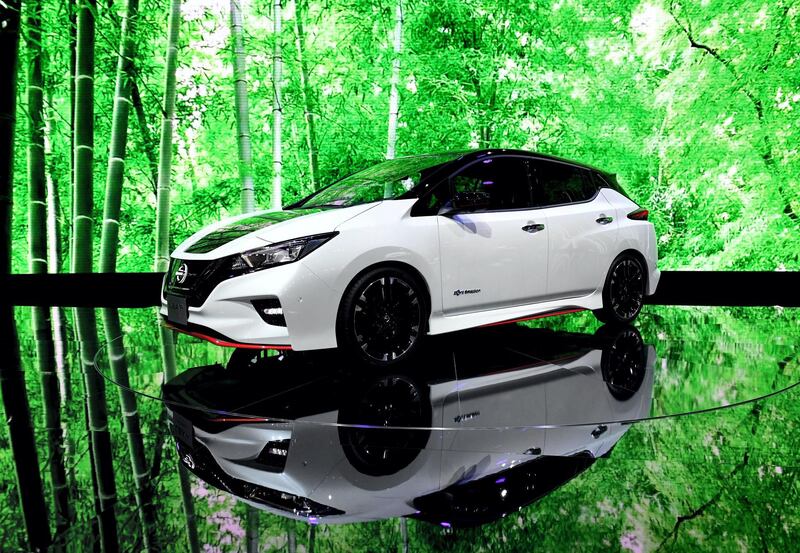“Men of big affairs are coming to appreciate more and more the electric’s wide sphere of usefulness in daily business life… even a child can run it”. So reads a 1912 advert from the Electric Vehicle Association of America, highlighting the ability of electric cars to drive in any weather and with no need for the driver to crank the vehicle up before setting off.
At that time, most electric cars reached speeds of around 20mph and were unable to travel very far without running out of power. Today’s electric cars, however, powered by lithium-ion batteries, have come a long way: a Tesla Model S recently travelled more than 620 miles on one charge.
Dr Anna Bonne, the transport lead at the UK’s Institution of Engineering and Technology, says that electric vehicles with a decent driving range on one charge, such as the small ones recently introduced by Renault and General Motors that cost less than £20,000 (Dh97,000), are also now becoming more affordable.
It’s unlikely, however, the new vehicles will be a one size fits all option – some are suited to short journeys within urban areas, while others are better for longer journeys between cities.
“It is likely that cars will be powered by electric batteries, but larger vehicles that need to travel a long distance with a heavy load will be powered by hydrogen as they won’t be able to get the range they need with current battery technology,” Dr Bonne said, adding that “there is also an option that larger commercial vehicles, such as lorries, could be powered by overhead power cables, but the infrastructure will be expensive to install.”
According to research from Shell, the number of electric cars will rise significantly from the 1.2 million recorded in 2015 to around 100 million by 2035 – or 6 per cent of the global fleet. Around a quarter of these electric vehicles are plug-in hybrids, which run on a mix of electric power and oil, and three quarters are battery electric vehicles.
Hydrogen fuel cells are also an option, with a small number of commercial vehicles on the road using them already; however, Paul Ekins, professor of resources and environment policy at UCL and co-director of the UK Energy Research Centre, believes the electric car will win out.
“Battery electric vehicles have a head start and if the battery continues to develop as it has over the last two or three years in terms of cost and performance, hydrogen fuel cell vehicles are going to find it pretty difficult to catch up,” says Prof Ekins, who does concede that it is possible there will be a mixture of hydrogen fuel cell and electric vehicles.

“There’s an enormous amount of innovation to come and it wouldn’t surprise me at all if we didn’t get hybrids of all kinds, [but] I think that battery electric vehicles will have a good share of the market”.
This view is shared within the industry. A spokesperson for Shell told The National that "a patchwork of solutions will be required for a successful and sustainable transition to a low-carbon future… Different types of vehicles and journeys have different requirements. We believe different fuels and engines will develop and co-exist to meet the growing demand for mobility with lower emissions."
Shell is actively developing a number of new fuels, including hydrogen, which they say “has the potential to play an important role in the energy transition” thanks to its flexibility and versatility. But it seems there is still a way to go, as the spokesperson added that “strong industry coordination and government support will be required for hydrogen to be deployed more broadly”.
The impetus for energy companies to futureproof themselves is clear, as set out in the 2017 edition of BP’s energy outlook, which states that a 100 million increase in electric cars could reduce oil demand growth by 1.4 million barrels per day. Self-driving cars, car sharing and ride pooling also contribute to fuel efficiencies.
Shell has said it plans to spend as much as US$1 billion a year on its New Energies division as the transition toward renewable power and electric cars accelerates. The company has said it also sees opportunities in hydrogen fuel cells and next-generation biofuels for air travel, shipping and heavy freight.
Royal Dutch Shell’s downstream director John Abbott told an audience at Imperial College in London: “the world will need many solutions, not one. Success is not about picking one winner. Shell’s concept for a retail station in the not-too-distant future, for example, sees conventional fuels being sold alongside hydrogen and expanded facilities for battery electric vehicle drivers as they wait for a full charge”.
One of the biggest challenges to accommodating this vision of the future is making sure the everyday infrastructure that will allow motorists to recharge and refuel these vehicles is available, with the speed and convenience people have come to expect.
Setting the standard, Beijing has set a target of having 800,000 charging sockets by the end of the year to cater for the world’s biggest market. To put five million energy-efficient vehicles on the roads by 2020, as it intends, China must tackle the shortage of charging facilities. This is something that countries such as the UK are only recently beginning to tackle, with Royal Dutch Shell opening its first rapid charging point for electric cars at three sites in the UK in early October 2017, with the intention of expanding to a further seven by the end of the year.

Should countries like Britain panic at the amount of work that remains to be done to build an environment suitable for large amounts of electronic vehicles?
Prof Ekins doesn’t think so. He said: “Charging infrastructure isn’t that expensive and I think we will have regulations that say local authorities have to provide a certain number of on-street charging infrastructures. Quite a lot of car parks will have charging infrastructures in them and obviously people will install them in their homes. They’ll have incentives to do that.”
Despite the hardware being a while off, innovative energy deals are springing up in anticipation of how our neighbourhoods could manage their energy needs. One example has seen Nissan and OVO energy plan to launch a vehicle-to-grid (V2G) offering for customers buying the new Nissan LEAF from January 2018. It will allow customers to sell energy back to the grid at peak times.
Nissan electric vehicle owners will be able to connect to the grid to charge at low-demand, cheap tariff periods. They can then use the electricity stored in the vehicle’s battery at home and at work when costs are higher, or even feed electricity back to the grid, which could generate revenue for the vehicle owner. OVO plans to create special tariffs to reward customers for this interaction with the grid.
In a future with widespread electric vehicle adoption, the companies say V2G technology could generate a virtual power plant of up to 200 giggawatts. This energy capacity is more than double the peak requirement on the UK grid.
_______________
Read more:
[ End of the internal combustion engine, part 1: how cars came to the UAE ]
[ End of the internal combustion engine, part 2: how climate change drove the race for an alternative ]
[ End of the internal combustion engine, part 4: an affection for classic cars lives on ]
_______________
Meanwhile, an alliance called CharIN, made up of companies including Shell, Jaguar Land Rover, BMW and Daimler, Siemens and Bosch, EWE, Continental and Man, is working on a system to help the grid handle the coming influx of electric vehicles. CharIN, an association dedicated to ensuring charging systems for battery electric vehicles have a global standard, is seeking to prevent localised power shortages when several people plug in their cars at the same time. Charging posts, the distribution of which CharIN is also invested in, would need to be smart and connected to enable communication with the grid. This would allow the posts to know when there is enough electricity in the system and when there isn’t, so you can choose when to charge. This model has been trialled for two years in London, Hamburg and San Diego.
Elon Musk’s dream to get an electric car in every household is also shared by inventor and entrepreneur James Dyson, who recently announced he intended to join the race to build electric cars.
Dyson, the entrepreneur’s engineering company best known for its vacuum cleaners and fans, plans to spend £2bn developing a "radical" electric car. The battery-powered vehicle is due to be launched in 2020 and 400 staff have been working on the secret project for the past two years.
The amount of money needed for the research of these new technologies is astronomical, but the amount of money to be made by whoever cracks it first is difficult to even imagine.
The accolade of producing the iconic engine of the century is waiting, ready to be grabbed.
History of the internal combustion engine

_______________
Read more:
[ The hydrogen-powered Toyota Mirai and the region's first hydrogen refuelling station land in Dubai ]






